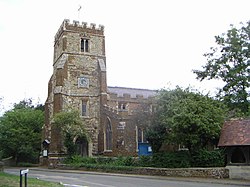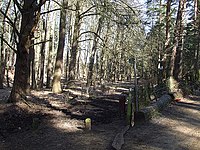Aspley Guise
| Aspley Guise | |
| Bedfordshire | |
|---|---|
 St Botolph's Church | |
| Location | |
| Grid reference: | SP942359 |
| Location: | 52°-0’45"N, 0°37’43"W |
| Data | |
| Population: | 2,195 (2011) |
| Post town: | Milton Keynes |
| Postcode: | MK17 |
| Local Government | |
| Council: | Central Bedfordshire |
Aspley Guise is a village in Bedfordshire, on the county boundary and adjoining Woburn Sands in Buckinghamshire. Aspley is 6 miles east of Milton Keynes in the latter county and a mile south of the M1 motorway's junction 13. It has its own railway station and a large historic centre with 29 listed buildings, four of which are in the second highest category.
The name 'Aspley' is derives from "Aspenlea" meaning the aspen meadow. The suffix 'Guise' is from the Guise family who owned the manor in the Middle Ages. Asperele and Aspel are recorded in Letter Patents, Assize Rolls and such documents of the 13th century.[1]
Contents
Parish church
The parish church is dedicated to St Botolph and was reworked extensively in the early and late 19th century.
Its tower has six bells. Its southern window of a nativity screen was installed during the last major series of renovations and is described by the church as "very fine".[2] The north aisle has a 15th-century traceried screen, a similarly dated circular font and a tomb chest with effigy of knight, probably Sir William Tyrington, estimated to date to c.1400. In this floor are typical brasses, one to John Danvers, rector, c.1410, another c.1500, probably to Sir John de Gyse/Guise.[3]
Sights about the village
Aspley has three historic houses of higher architectural classification. Its church, equally, is Grade II* listed. The garden walls and gateway of Aspley House are listed in an entry separate from it,[4] giving 30 structures in all identified by English Heritage as worthy of listing.
Aspley House
This was built in 1695 in the style of Sir Christopher Wren and altered c. 1750 and again later.[5] In 1912 this house still contained many fine portraits of the Hervey and Chernock families.[1]
Guise House
In the 18th century, Guise House and its grounds were home to (Aspley) Classical Academy until 1845, a school at its peak rated to rival Eton and Harrow. It has above its façade a Greek-style open pediment with windows in its tympanum (triangular area). It has a stone parapet tower.[6]
The Old House
The Old House is timber-framed (of typical Tudor architectural construction) and dates from 1575 with some Georgian alterations. [7]
Others
The village has 26 other examples of listed architecture, many of them early Georgian.
History
Early history
The first record of Aspley occurs in 969, when land there comprising 15 hides was granted by King Edgar to his thegn Alfwold.[1]
By the time of the Domesday Book, 1086, the parish had 25 households, five of which were recorded as serfs, most of whom may not have been able to have their own households. The Book notes it covered a large tract of agricultural land, valued at £10 to its overlords, though rendering only £8, and was held before the conquest by Leofeva of Earl Waltheof. Its contemporary manor owner was Acard of Ivry who held of Hugh of Beauchamp, its feudal overlord.
In total were 12 ploughlands (larger than average), 10 ploughs of meadow, woodland producing 50 hogs per year, one mill however the Book records no church at that date.[8]
Its church is mentioned in the records of the diocese in 1223.[2]
Aspley Manor
Most of the cultivated land was held by the manor in the Middle Ages.[1] This stayed in Acard's family until his descendant, Reginald de Ivri granted a lease to Falkes de Breauté. On the confiscation of Falkes's estates in 1225 the relatively young King Henry III granted the rest of the lease to Henry de Capella, however by 1227 a certain "Reginald de St. Valery" was free to release the land to his regent, now Henry was a 20-year old adult, Hubert de Burgh, 1st Earl of Kent, with an official approval.[1] However, in 1233 the King confiscated his lands. Hubert was restored to all his wealth the following year in the Testa de Nevill. By 1267 it is established in the royal returns and copies of letters that he had subinfeudated the manor to Anselm de Gyse, in return for knight's service to John de Burgh and heirs.
After the middle of the 14th century the heirs of Hubert de Burgh in Aspley seem to have lapsed, and the manor was held directly of the barony of Bedford.
As such the tenancy's was in this period the de Guise's. Anselm died in 1295 left as heir a son John, then aged seventeen - his descendants inherited this tenancy and became direct tenants as mentioned. The House of Gyse retained the manor's thereafter until the Tudor period.
In 1541 the manor of Aspley Guise was annexed to the newly formed honour of Ampthill, which in 1551 was granted for life to Princess Elizabeth (later Queen Elizabeth I). An extent of the manor in 1560 mentions two windmills, but none survive in the historic ecclesiastical parish. In 1560 the Queen gave this asset by royal grant to Sir Richard Lee, military engineer: summarised as being worth a fairly average £14 13s. 11½d., &c. a year. His daughter Ann, later Mrs Ralph Norwich, received permission to alienate (sell) the manor to Francis Bury, whose heir, Frances, by arrangement or fate married Ann's grandson, Thomas Lee Sadleir.
The estate passed down in a straightforward line of Sadleirs to Richard Vernon Sadleir who died in 1810, whose sister Ursula Moody inherited it. The owner in 1912 was accordingly her descendant, a certain Mr F. Moody.[1]
The current manor house was built about 1700.[9]
Rectory
As to the church lands and tithes, in 1317 a further confirmation of Simon de Beauchamp's grant of the church and two parts of the tithes was made in favour of Newnham Priory. In 1544, these lands and the advowson were released by John Gyse and Anselm his son and heir to the Crown. In the Dissolution of the Chantries (a year before the Dissolution of the Monasteries) an acre here was appropriated by the crown and its proceeds given to fund a new church window.[1] What remained of the rectory was consolidated the vicarage of Husborne Crawley in 1796 and re-established half a century later.
The Church Charities
The Town Close, administered by the ecclesiastical parish, containing 4.75 acres awarded under the Inclosure Act 1761, by 1912 still produced for the poor agricultural produce worth £8 18s. a year, which was expended from time to time on its produce growers' work.[1]
20th century
In the early 20th century large brickworks, with clay extraction was the main industry in the parish itself, having ceased by that century the extraction of fuller's earth, on which profit was no longer possible. Agriculture, as today formed a minority of employment.[1]
The Rookery, a secluded Victorian mansion in Church Street, was used by intelligence operatives during the Second World War for black propaganda against Germany controlled by Sefton Delmer.[10]
Aspley Guise Triangle
The 'Aspley Guise triangle' is its northern area of farmland targeted to be concreted to expand Milton Keynes. It is bounded by the A421 to the north and northeast and the Marston Vale line to the south (which separates it from the developed and recreational areas of Aspley Guise) and Cranfield Road to the west. It had been labelled with this term in the regional body's expansion plans for Milton Keynes and identified as an appropriate possibility, being served by a railway station. In the ministerial ruling on the plan, this area was excluded on the technicality that it is not part of the South East of England Region, though with a hint that it might appear again in an East of England regional spatial strategy, which had its own fulfilled plans.[11]
Following the 2010 United Kingdom general election, the coalition government cancelled its predecessor's regional housing targets and bodies, and the local authority has no plans to introduce a development plan to permit the urbanisation of the northern part of the parish.
Outside links
| ("Wikimedia Commons" has material about Aspley Guise) |
References
- ↑ 1.0 1.1 1.2 1.3 1.4 1.5 1.6 1.7 1.8 Parishes: Aspley Guise - A History of the County of Bedford: Volume 3
- ↑ 2.0 2.1 Church of England (a church near you)
- ↑ National Heritage List 1312070: St Botolph's Church, Apsley Guise
- ↑ National Heritage List 1113953: Aspley House's Gateway and Garden Wall
- ↑ National Heritage List 1113948: Aspley House
- ↑ National Heritage List 1113952: Guise House
- ↑ The Old House National Heritage List 1113954: The Old House
- ↑ Domesday Map
- ↑ National Heritage List 1321714: Aspley Guise
- ↑ The Rookery, Aspley Guise - Bedfordshire Record Office, accessed 26 July 2010
- ↑ Consultation Home > Regional Spatial Strategy (RSS) > Proposed Changes for Consultation > Secretary of State's Proposed Changes 23 > Milton Keynes and Aylesbury Vale Commentary on chapter 23(5).
